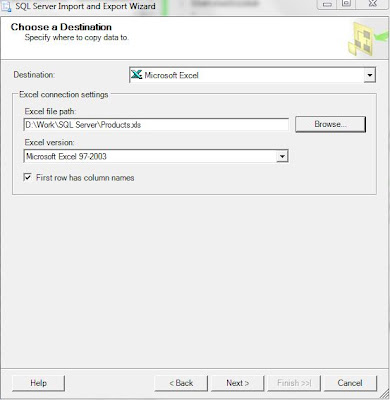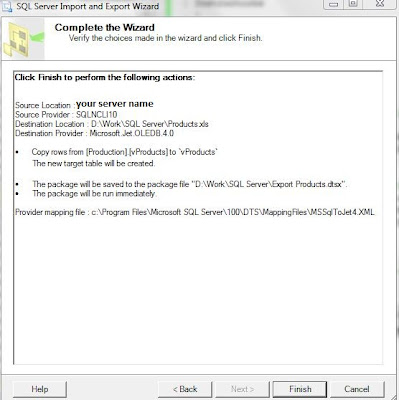Step 1: Start SQL Server Import and Export Wizard
From SQL Server Management Studio choose the database from which you want to export the data (e.g. AdventureWorks), right click on it and from the floating menu choose Tasks/Export Data. This action will bring the ‘SQL Server Import and Export Wizard’ used, as its name indicates, for importing and exporting data on the fly from/to SQL Server or any other source.
 Step 2: Choose a Data Source
Step 2: Choose a Data Source
In ‘Choose a Data Source’ step select the ‘Data Source’, SQL Server Native Client 10.0 for exporting data from SQL Server, choose ‘Server name’ from the list of SQL Server available, select the Authentication mode and the Database (e. g. AdventureWorks), then proceed to the next step by clicking ‘Next’.
 Step 3: Choose a Destination
Step 3: Choose a Destination
In ‘Choose a Destination’ step select the Destination, in this case ‘Microsoft Excel’, browse for the Excel file to which you want to export the data (e.g. Products.xls) and check ‘First row has column names’ in case you want to include the column names, then proceed to the next step by clicking ‘Next’.
 Step 4: Specify Table Copy or Query
Step 4: Specify Table Copy or Query
In ‘Specify Table Copy or Query’ step there are two options you could choose: ‘Copy data from one or more tables or views’ or ‘Write a query to specify the data to transfer’ – their names are speaking for itself. The second option allows for more flexibility and you could just copy paste the query used for your expert. In this example just go with the first option and then proceed to the next step by clicking ‘Next’.
 Step 5: Select Source Tables and Views
Step 5: Select Source Tables and Views
In ‘Select Source Tables and Views’ step select the database objects (e.g. Production.vProducts) from which you’ll export the data, then proceed to the next step by clicking ‘Next’. If the destination allows it, it’s possible to choose more than one database object.
 Step 6: Review Data Type Mapping
Step 6: Review Data Type Mapping
In ‘Review Data Type Mapping’ typically you could go with the provided defaults thus you can proceed to the next step by clicking ‘Next’.
 Step 7: Save and Run Package
Step 7: Save and Run Package
In ‘Save and Run Package’ step you could choose to ‘Run immediately’ the package and/or ‘Save SSIS Package’ to the ‘SQL Server’ or locally to the ‘File System’. Saving the package locally allows you to modify and rerun the package at a later date. For this example check the ‘Run immediately’, respectively the ‘Save SSIS Package’ and ‘File System’ option, then proceed to the next step by clicking ‘Next’.
 Step 8: Save SSIS Package
Step 8: Save SSIS Package
In ‘Save SSIS Package’ step provide the intended Name (e.g. Export Products) or Description of the Package, choose the location where the package will be saved, then proceed to the next step by clicking ‘Next’.
 Step 9: Complete the Wizard
Step 9: Complete the Wizard
The ‘Complete the Wizard’ step allows reviewing the choices made in the previous steps and eventually navigating to the previous steps in order and to the needful changes. Therefore once you proved the details proceed to the next step by clicking ‘Next’.
 Step 10: Executing the Package
Step 10: Executing the Package
In ‘Executing the Package’ step the Package is run, the progress being shown as each step. Just close the Package once you reviewed the steps.
 If the package run successfully you can go on and check the exported data, apply additional formatting, etc.
If the package run successfully you can go on and check the exported data, apply additional formatting, etc.
Step 11: Inspecting the Package
The package can be reopened and modified in Microsoft Visual Studio or SQL Server Business Intelligence Development Studio, for this just open one of the two environments and from the Main Menu select File/Open File, then browse for the location where the Package (e.g. Export Products.dtsx) was saved and open the file. Here is the package created by the Wizard:
 As can be seen the package contains two tasks, the ‘Preparation SQL Task 1’ which creates the table (e.g. vProducts) in the Excel file, and ‘Data Flow Task 1’ which dumps the data in the created table. By double clicking the ‘Data Flow Task 1’ you could see its content:
- the ‘Source - vProducts’ OLEDB Data Source holding the connectivity information to the SQL Server and the list of Columns in scope.
- the ‘Data Conversion’ Transformation that allows converting the data between Source and Destination given the fact that Excel has different data types than SQL Server
- the ‘Destination - vProducts’ Excel Destination holding the connectivity information for the Excel file and the Mappings in place.
As can be seen the package contains two tasks, the ‘Preparation SQL Task 1’ which creates the table (e.g. vProducts) in the Excel file, and ‘Data Flow Task 1’ which dumps the data in the created table. By double clicking the ‘Data Flow Task 1’ you could see its content:
- the ‘Source - vProducts’ OLEDB Data Source holding the connectivity information to the SQL Server and the list of Columns in scope.
- the ‘Data Conversion’ Transformation that allows converting the data between Source and Destination given the fact that Excel has different data types than SQL Server
- the ‘Destination - vProducts’ Excel Destination holding the connectivity information for the Excel file and the Mappings in place.
 You could explore the properties of each object in order to learn more about its attributes used and the values they took.
You could explore the properties of each object in order to learn more about its attributes used and the values they took.
Ok, so you’ve open the package, how do you run it again? For this is enough to double click on the locally saved Package (e.g. Export Products.dtsx), action that will bring the ‘Execute Package Utility’, and click on the ‘Execute’ button to run the Package.
 If you haven’t done any changes to the Excel file to which you moved the data (e.g. Products.xls) and haven’t moved the file, then the package will fail when it attempts to run the ‘the ‘Preparation SQL Task 1’ task because a table with the expected name already exists in the file.
If you haven’t done any changes to the Excel file to which you moved the data (e.g. Products.xls) and haven’t moved the file, then the package will fail when it attempts to run the ‘the ‘Preparation SQL Task 1’ task because a table with the expected name already exists in the file.
 In order to avoid this error to appear you’ll have to delete from the Excel file the sheet (e.g. vProducts) where the data were dumped and save the file. Now you could execute again the package and it should execute without additional issues.
In order to avoid this error to appear you’ll have to delete from the Excel file the sheet (e.g. vProducts) where the data were dumped and save the file. Now you could execute again the package and it should execute without additional issues.
If you’ve removed/deleted the Excel file, even if you get a warning that the Excel file is not available, the package will run in the end without problems. Instead of deleting the sheet manually you could use the File System Task to move the file to other location, though that’s a topic for another post.

No comments:
Post a Comment